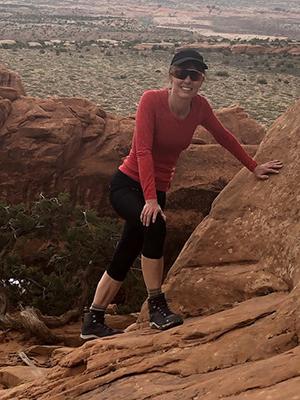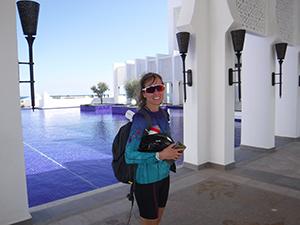Five questions for Cathy Bradley
What happens if you become ill and don’t have health insurance? Or perhaps you have insurance but worry that too much time away from your work could risk your employment.
Those questions pushed Cathy Bradley to examine cancer and employment, including what happens to women when they are diagnosed with breast cancer but have to work to keep their health insurance and also maintain critical treatment.
“I find health care to be a fascinating area of study, and especially the intersection with cancer because cancer is a disease where people have to make decisions. They can’t ignore it like they might ignore blood pressure or other types of problems. They have to do something about it, and usually it is something pretty aggressive,” said Bradley, who joined CU four years ago.
She is the Colorado School of Public Health’s associate dean for research and is the deputy director of the University of Colorado Cancer Center, where she holds the Grohne Chair in Cancer Prevention and Control research.
1. How do your two roles intersect?
My role as deputy director of the Cancer Center is all about growing research and developing the center to be as successful as it possibly can be. Our measure of success is how well our researchers are doing regarding new discoveries and treatments and being on the cutting edge of providing state-of-the-art care. I also cultivate research in my role as the associate dean.
The School of Public Health has just gone through a strategic planning process where they set some priorities, and my job is to figure out how to achieve those priorities related to research.
Both roles are about developing research across faculty and trying to figure out activities that would help stimulate research and increase their chances of success.
Part of the Cancer Center’s agenda is prevention and control, and almost all that type of research comes from the School of Public Health faculty. In that sense, the roles overlap not only in general function but with the people in cancer prevention and control. My job is to provide mentorship to junior faculty who are trying to get started or faculty who have gotten their first grant but need support in getting their next one.
In general, I’m also interested in what the school can do to make faculty more successful, whether it be training, symposia, workshops, pilot programs, seminars, or helping them prioritize what should and should not be done.
Funding is really, really tight. The pay lines are very low and faculty across the country – all of whom are very smart -- are competing for the same dollars. Researchers, however, can learn to make their applications more competitive. Faculty have to learn how to respond to reviewers, how to pitch their proposal, how to lay it out, and how to communicate more effectively.
The other thing that is harder to teach new researchers is how to ask a good research question that funders care about. If you have a really great and interesting research question that no one really cares about or there is not a funding mechanism for, it will not score very well. What we want to do is take an idea that may be fairly nascent and turn it into something competitive so researchers can get funding and do innovative things that they would not have the chance to do otherwise.
I look at it like an entrepreneurial pursuit. You have to sell your idea; your marketing plan is your proposal. I’m trying to help researchers hone their ideas and maximize their chances for success.
2. Some of your own research focuses on health care and health insurance. What has your study discovered?
There are two lines of research that I’ve pursued in my career. One is around the intersection of work and illness. I started looking at labor market outcomes of breast and prostate cancer survivors to understand the interplay of health insurance and employment-based health insurance and whether providing insurance outside of the employer would cause an exodus of sick people. I’ve done a lot of work in the area using quasi-experimental designs, looking at women who are insured by their own employer and women who have insurance though their spouses’ employers and how their behavior differs.
I found that there is not a lot of mass exodus from jobs, but there’s a whole lot less stress if you’re not working to make sure you have insurance. In some of the cases I studied, people told me they would skip chemotherapy rather than risk losing their jobs, especially if their insurance also covered their family. That creates a stark choice for people who are sick, especially because cancer is an expensive disease to treat. I’ve studied over 2,000 breast-cancer patients and about 300 prostate cancer patients to try to understand these choices.
We want to look at the long-term implications from a policy perspective. If we provide a non-employment health insurance option, do we incentivize people to leave the workplace? Or by only having an employer-based insurance base, are we causing people to make choices that are not in their best interests?
The other area of research I’ve pursued is health disparities, especially those related to socio-economic disparities and health insurance. If you have a public insurance plan like Medicaid, are you susceptible to bad outcomes more so than people with private insurance when you are diagnosed with cancer? I conducted research where it looked like people with Medicaid had terrible outcomes, but when I dug deeper, I found that it was because they didn’t get on Medicaid until after being diagnosed. They had long periods of being uninsured, then they were diagnosed with cancer at late stage and were treated extremely aggressively and then they died. It’s not that Medicaid is killing people, it’s that we have so many uninsured people and by the time they are qualified for Medicaid, it’s often too late.
I looked at urban and rural differences in Colorado to see if there are differences in how people are treated and cared for depending on their insurance and where they live. Colorado has a unique situation: If you live in a rural area, you are on the other side of the mountain since our only comprehensive cancer center is on the CU Anschutz campus. It can be quite a barrier since not everyone can travel.
3. In August, you received a nearly $4 million grant for a project with the goal of lessening the impacts of stress on cancer caregivers who also are employed. What do you hope to achieve with this project?
This is a collaboration with Mark Laudenslager, who is a psychologist and has an intervention for stress reduction for cancer caregivers. He and I started talking about our areas of work and decided that it would be fun to work together and apply his stress-reduction approaches and interventions to employed caregivers. It’s that generation of people who are trying to work and care for their loved one and probably have other responsibilities like children or older parents and who have lots of stress in terms of keeping all the balls in the air. They are in desperate need of help.
We will apply Mark’s intervention to my population of interest. I’m going to study the employment outcomes and the medical care utilization components of it while he is delivering the stress reduction intervention. He does lots of work using biomarkers and telomere length and hair cortisol, and we’ll be able to measure physiologically when a person is faced with stress related to employment and caregiving.
We hope to objectively understand what employment-related stress does to an individual and identify those people who are on a bad path and help them proactively.
4. You mentioned that you are examining the health differences between rural and urban Colorado populations. How is the Cancer Center helping state residents?
The Cancer Center is laser-focused on Colorado and what we need to do to reduce the burden of cancer in the state. A lot of what we do is make sure our research is targeted to our citizens while also having both national and international impact.
We’ve expanded colorectal cancer screening and we’re looking at improving the rate of HPV vaccinations. We’re identifying vulnerable populations, and in Colorado, that is our Latino and rural populations, and we’re making sure we have outreach efforts to them. We are starting to look more carefully at vaping behaviors and tobacco product use and trying to understand that better.
Colorado has a dichotomous population: one is the healthy, young, physically active population who we typically see running around the Front Range – and then one that is less healthy and in need of preventive care.
5. What hobbies or activities do you enjoy outside of the university?
I’m pretty physically active. I just got back from an eight-day bike trip in Morocco. To be honest, it was an amazing trip, but it was hard. Since moving to Colorado, I’ve gotten into outdoor activities of hiking and cycling. Whenever I can, I like to travel; I like adventure. I was crazy for doing the Morocco trip, but I’m glad I did it. I grew up on the ocean, so I always like to make sure I visit a beach a couple times a year. I am hoping to get to South America sometime, maybe Patagonia.




